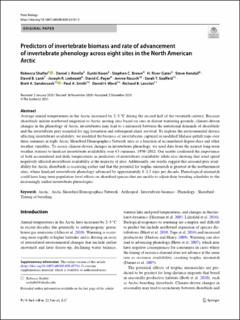| dc.contributor.author | Shaftel, Rebecca | |
| dc.contributor.author | Rinella, Daniel J. | |
| dc.contributor.author | Kwon, Eunbi | |
| dc.contributor.author | Brown, Stephen C. | |
| dc.contributor.author | Gates, H. River | |
| dc.contributor.author | Kendall, Steve | |
| dc.contributor.author | Lank, David B. | |
| dc.contributor.author | Liebezeit, Joseph R. | |
| dc.contributor.author | Payer, David C. | |
| dc.contributor.author | Rausch, Jennie | |
| dc.contributor.author | Saalfeld, Sarah T. | |
| dc.contributor.author | Sandercock, Brett | |
| dc.contributor.author | Smith, Paul A. | |
| dc.contributor.author | Ward, David H. | |
| dc.contributor.author | Lanctot, Richard B. | |
| dc.coverage.spatial | Arctic | en_US |
| dc.date.accessioned | 2023-03-03T09:36:50Z | |
| dc.date.available | 2023-03-03T09:36:50Z | |
| dc.date.created | 2021-01-25T09:32:34Z | |
| dc.date.issued | 2021 | |
| dc.identifier.issn | 0722-4060 | |
| dc.identifier.uri | https://hdl.handle.net/11250/3055678 | |
| dc.description.abstract | Average annual temperatures in the Arctic increased by 2–3 °C during the second half of the twentieth century. Because
shorebirds initiate northward migration to Arctic nesting sites based on cues at distant wintering grounds, climate-driven
changes in the phenology of Arctic invertebrates may lead to a mismatch between the nutritional demands of shorebirds
and the invertebrate prey essential for egg formation and subsequent chick survival. To explore the environmental drivers
afecting invertebrate availability, we modeled the biomass of invertebrates captured in modifed Malaise-pitfall traps over
three summers at eight Arctic Shorebird Demographics Network sites as a function of accumulated degree-days and other
weather variables. To assess climate-driven changes in invertebrate phenology, we used data from the nearest long-term
weather stations to hindcast invertebrate availability over 63 summers, 1950–2012. Our results confrmed the importance
of both accumulated and daily temperatures as predictors of invertebrate availability while also showing that wind speed
negatively afected invertebrate availability at the majority of sites. Additionally, our results suggest that seasonal prey avail ability for Arctic shorebirds is occurring earlier and that the potential for trophic mismatch is greatest at the northernmost
sites, where hindcast invertebrate phenology advanced by approximately 1–2.5 days per decade. Phenological mismatch
could have long-term population-level efects on shorebird species that are unable to adjust their breeding schedules to the
increasingly earlier invertebrate phenologies. | en_US |
| dc.language.iso | eng | en_US |
| dc.rights | Navngivelse 4.0 Internasjonal | * |
| dc.rights.uri | http://creativecommons.org/licenses/by/4.0/deed.no | * |
| dc.subject | Arctic | en_US |
| dc.subject | Arctic Shorebird Demographics Network | en_US |
| dc.subject | Arthropod | en_US |
| dc.subject | Invertebrate biomass | en_US |
| dc.subject | Phenology | en_US |
| dc.subject | Shorebird | en_US |
| dc.subject | Timing of breeding | en_US |
| dc.title | Predictors of invertebrate biomass and rate of advancement of invertebrate phenology across eight sites in the North American Arctic | en_US |
| dc.type | Peer reviewed | en_US |
| dc.type | Journal article | en_US |
| dc.description.version | publishedVersion | en_US |
| dc.rights.holder | © 2021 The Authors | en_US |
| dc.subject.nsi | VDP::Matematikk og Naturvitenskap: 400::Zoologiske og botaniske fag: 480 | en_US |
| dc.source.pagenumber | 237-257 | en_US |
| dc.source.volume | 44 | en_US |
| dc.source.journal | Polar Biology | en_US |
| dc.identifier.doi | 10.1007/s00300-020-02781-5 | |
| dc.identifier.cristin | 1878103 | |
| cristin.ispublished | true | |
| cristin.fulltext | original | |
| cristin.qualitycode | 1 | |

